
Building operations company Johnson Controls (NYSE: JCI) beat Wall Street’s revenue expectations in Q3 CY2025, with sales up 3.1% year on year to $6.44 billion. On the other hand, next quarter’s revenue guidance of $5.59 billion was less impressive, coming in 2.5% below analysts’ estimates. Its non-GAAP profit of $1.26 per share was 4.7% above analysts’ consensus estimates.
Is now the time to buy Johnson Controls? Find out by accessing our full research report, it’s free for active Edge members.
Johnson Controls (JCI) Q3 CY2025 Highlights:
- Revenue: $6.44 billion vs analyst estimates of $6.34 billion (3.1% year-on-year growth, 1.6% beat)
- Adjusted EPS: $1.26 vs analyst estimates of $1.20 (4.7% beat)
- Revenue Guidance for Q4 CY2025 is $5.59 billion at the midpoint, below analyst estimates of $5.73 billion
- Adjusted EPS guidance for the upcoming financial year 2026 is $4.55 at the midpoint, beating analyst estimates by 2.7%
- Operating Margin: 5.5%, down from 11.9% in the same quarter last year
- Free Cash Flow Margin: 13%, down from 18.5% in the same quarter last year
- Organic Revenue rose 3% year on year vs analyst estimates of 1.4% growth (164.4 basis point beat)
- Market Capitalization: $72.66 billion
"Johnson Controls delivered a strong year, with double-digit EPS growth and a record backlog of $15 billion, up 13%, reflecting sustained demand in our core verticals," said Joakim Weidemanis, CEO.
Company Overview
Founded after patenting the electric room thermostat, Johnson Controls (NYSE: JCI) specializes in building products and technology solutions, including HVAC systems, fire and security systems, and energy storage.
Revenue Growth
Reviewing a company’s long-term sales performance reveals insights into its quality. Any business can experience short-term success, but top-performing ones enjoy sustained growth for years. Over the last five years, Johnson Controls grew its sales at a weak 1.1% compounded annual growth rate. This was below our standards and is a poor baseline for our analysis.
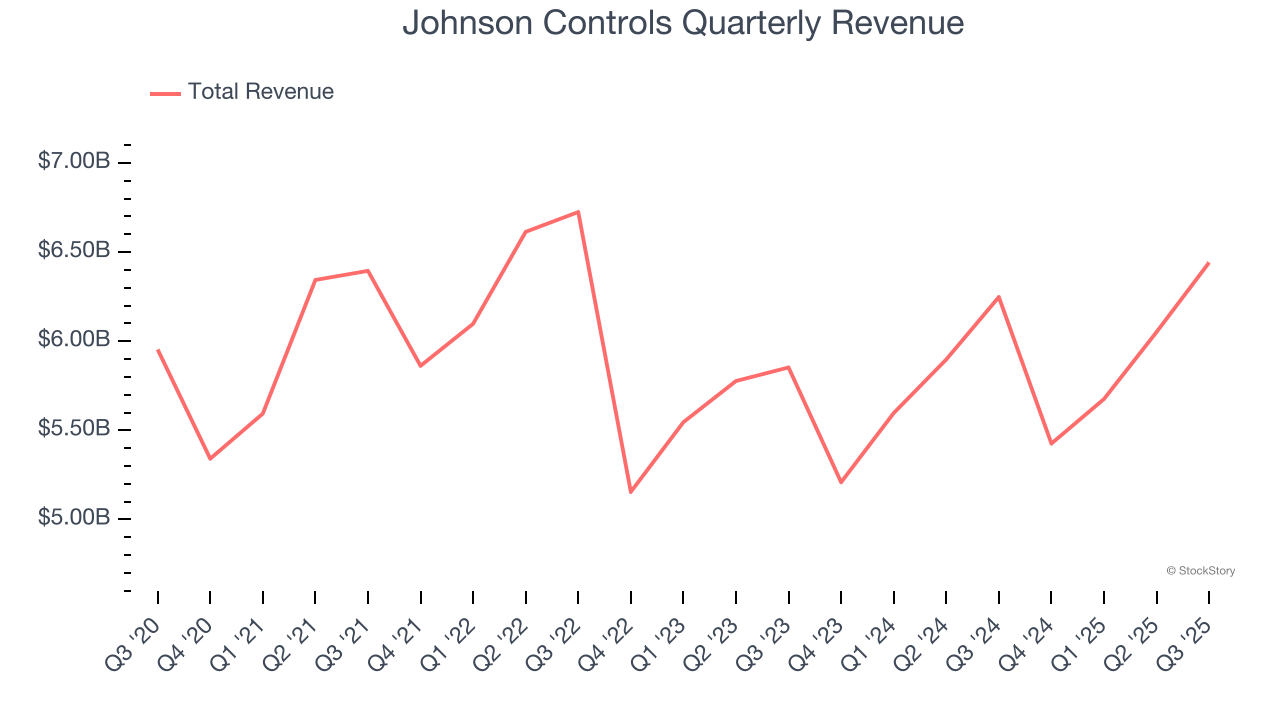
We at StockStory place the most emphasis on long-term growth, but within industrials, a half-decade historical view may miss cycles, industry trends, or a company capitalizing on catalysts such as a new contract win or a successful product line. Johnson Controls’s annualized revenue growth of 2.8% over the last two years is above its five-year trend, but we were still disappointed by the results. 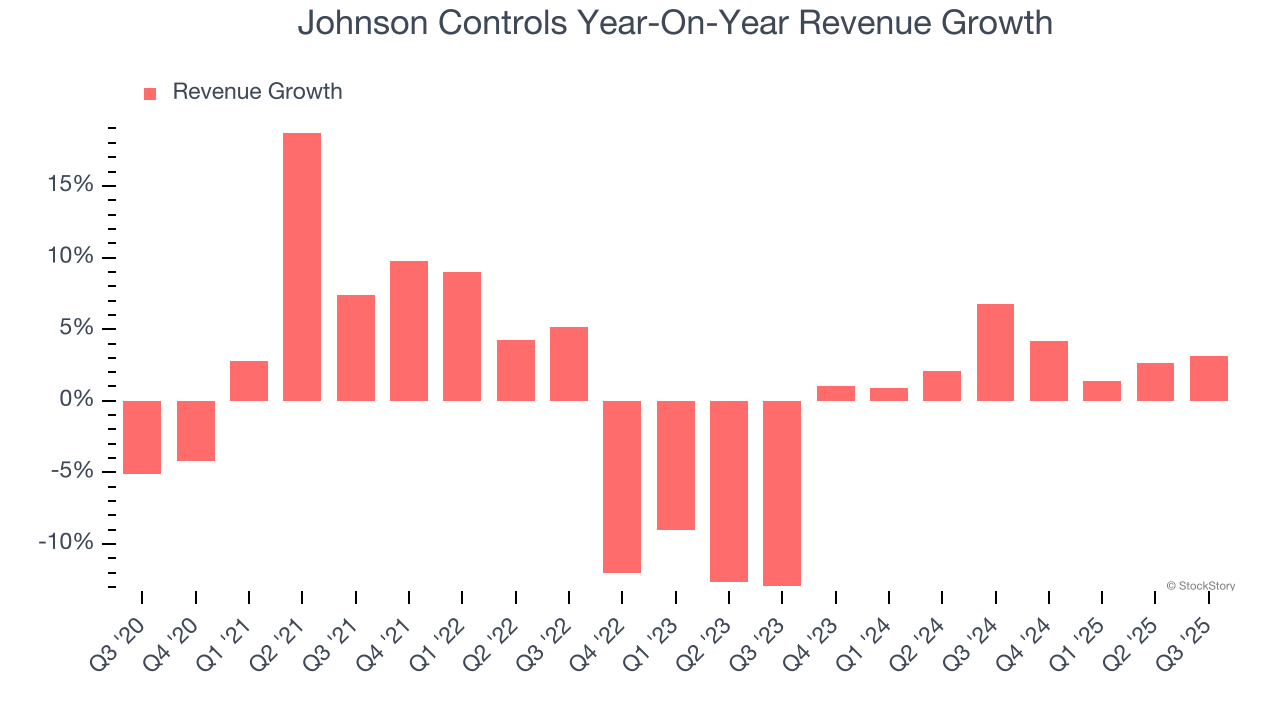
Johnson Controls also reports organic revenue, which strips out one-time events like acquisitions and currency fluctuations that don’t accurately reflect its fundamentals. Over the last two years, Johnson Controls’s organic revenue averaged 4.9% year-on-year growth. Because this number is better than its two-year revenue growth, we can see that some mixture of divestitures and foreign exchange rates dampened its headline results. 
This quarter, Johnson Controls reported modest year-on-year revenue growth of 3.1% but beat Wall Street’s estimates by 1.6%. Company management is currently guiding for a 3% year-on-year increase in sales next quarter.
Looking further ahead, sell-side analysts expect revenue to grow 5.3% over the next 12 months. Although this projection indicates its newer products and services will catalyze better top-line performance, it is still below average for the sector.
Microsoft, Alphabet, Coca-Cola, Monster Beverage—all began as under-the-radar growth stories riding a massive trend. We’ve identified the next one: a profitable AI semiconductor play Wall Street is still overlooking. Go here for access to our full report.
Operating Margin
Johnson Controls has done a decent job managing its cost base over the last five years. The company has produced an average operating margin of 8.7%, higher than the broader industrials sector.
Analyzing the trend in its profitability, Johnson Controls’s operating margin decreased by 2.6 percentage points over the last five years. This raises questions about the company’s expense base because its revenue growth should have given it leverage on its fixed costs, resulting in better economies of scale and profitability.
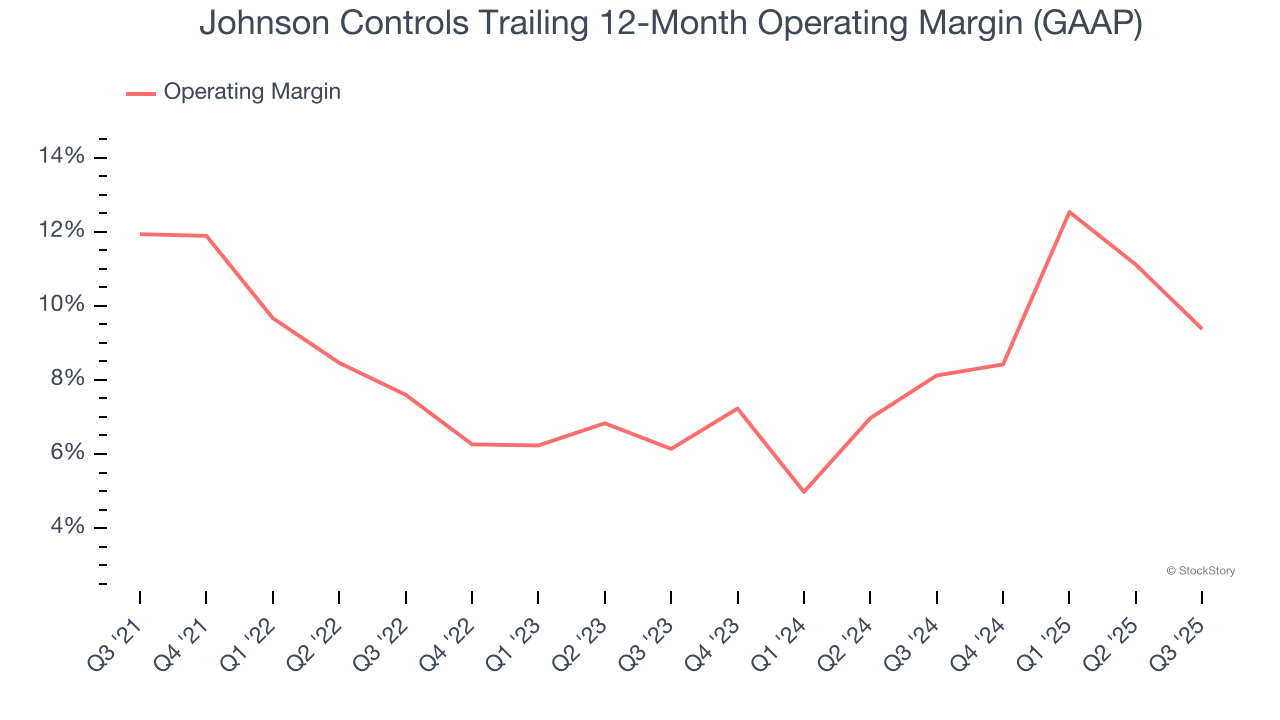
In Q3, Johnson Controls generated an operating margin profit margin of 5.5%, down 6.4 percentage points year on year. Since Johnson Controls’s operating margin decreased more than its gross margin, we can assume it was less efficient because expenses such as marketing, R&D, and administrative overhead increased.
Earnings Per Share
Revenue trends explain a company’s historical growth, but the long-term change in earnings per share (EPS) points to the profitability of that growth – for example, a company could inflate its sales through excessive spending on advertising and promotions.
Johnson Controls’s EPS grew at a solid 10.9% compounded annual growth rate over the last five years, higher than its 1.1% annualized revenue growth. However, this alone doesn’t tell us much about its business quality because its operating margin didn’t improve.
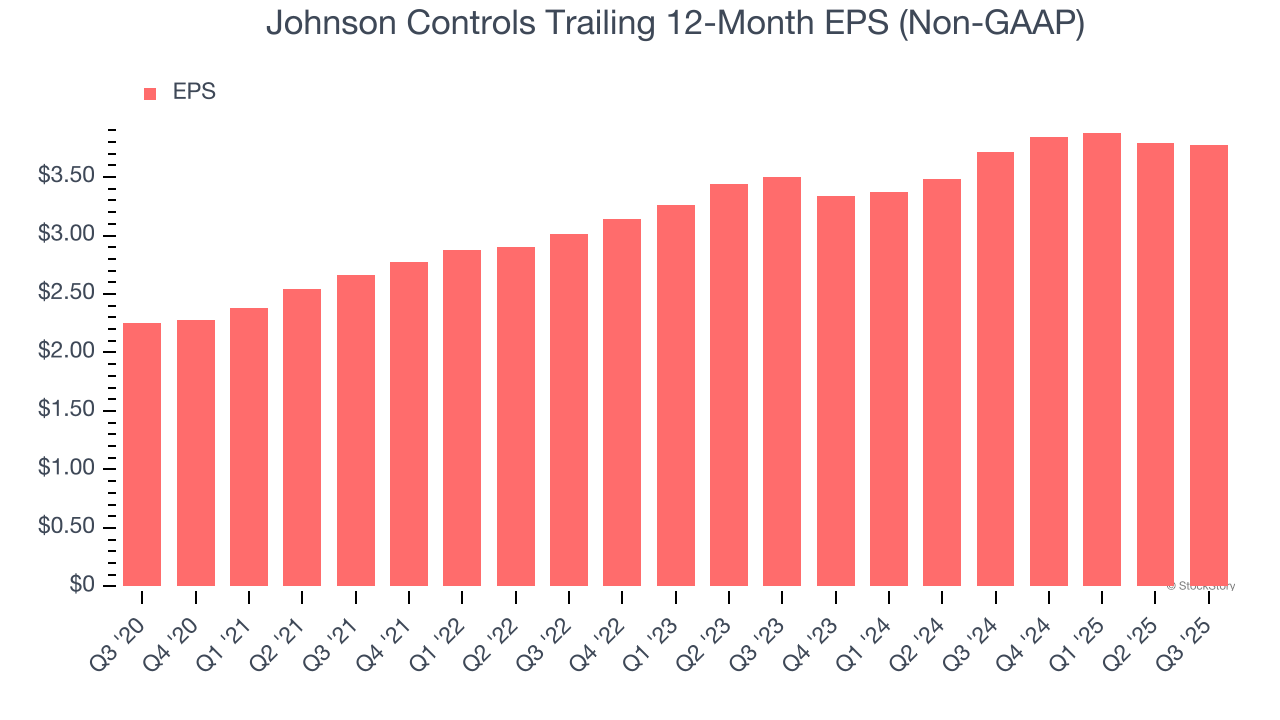
Diving into Johnson Controls’s quality of earnings can give us a better understanding of its performance. A five-year view shows that Johnson Controls has repurchased its stock, shrinking its share count by 14.2%. This tells us its EPS outperformed its revenue not because of increased operational efficiency but financial engineering, as buybacks boost per share earnings. 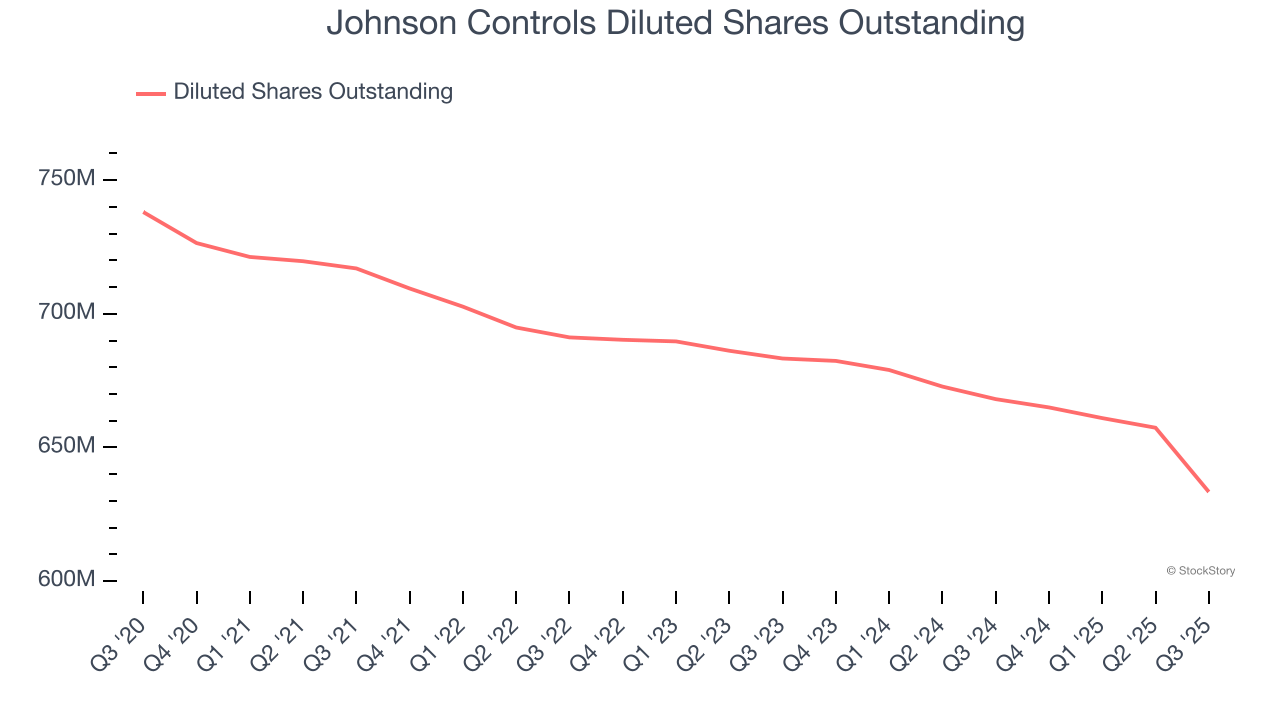
Like with revenue, we analyze EPS over a more recent period because it can provide insight into an emerging theme or development for the business.
For Johnson Controls, its two-year annual EPS growth of 3.8% was lower than its five-year trend. We hope its growth can accelerate in the future.
In Q3, Johnson Controls reported adjusted EPS of $1.26, down from $1.28 in the same quarter last year. Despite falling year on year, this print beat analysts’ estimates by 4.7%. Over the next 12 months, Wall Street expects Johnson Controls’s full-year EPS of $3.77 to grow 18.3%.
Key Takeaways from Johnson Controls’s Q3 Results
It was great to see Johnson Controls’s full-year EPS guidance top analysts’ expectations. We were also glad its organic revenue outperformed Wall Street’s estimates. On the other hand, its revenue guidance for next quarter fell short of Wall Street’s estimates. Overall, this print was mixed but still had some key positives. The stock traded up 3.6% to $115.07 immediately following the results.
Should you buy the stock or not? What happened in the latest quarter matters, but not as much as longer-term business quality and valuation, when deciding whether to invest in this stock. We cover that in our actionable full research report which you can read here, it’s free for active Edge members.





